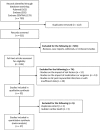Atrial fibrillation as a prognostic indicator of myocardial infarction and cardiovascular death: a systematic review and meta-analysis
- PMID: 28611377
- PMCID: PMC5469813
- DOI: 10.1038/s41598-017-03653-5
Atrial fibrillation as a prognostic indicator of myocardial infarction and cardiovascular death: a systematic review and meta-analysis
Abstract
This study aimed to investigate whether atrial fibrillation (AF) predicts myocardial infarction (MI) or cardiovascular (CV) death. AF is a well-established risk factor for thrombotic stroke and all-cause mortality. PubMed, EmBase, and Cochrane Central were searched for articles comparing the incidence rates of MI, CV death, or CV events between AF and non-AF patients. Relative risk ratio (RR) was used as effect estimate. Crude and adjusted RRs were calculated. Data were pooled using a random-effects model. The meta-analysis included 27 studies. In the unadjusted analysis, AF patients had a nonsignificant trend toward a higher risk of MI compared with non-AF patients; however, a significant association was found. The crude data analysis showed that AF was associated with increased risk of CV death (P < 0.05) and CV events (P < 0.05). These associations remained significant after pooling data from adjusted models (CV death: RR = 1.95, 95% CI 1.51-2.51, P < 0.05; CV events: RR = 2.10, 95% CI 1.50-2.95, P < 0.05). These results showed that AF is an independent risk factor for MI, CV death, and CV events.
Conflict of interest statement
The authors declare that they have no competing interests.
Figures









Similar articles
-
Impact of chronic obstructive pulmonary disease on prognosis in atrial fibrillation: A report from the EURObservational Research Programme Pilot Survey on Atrial Fibrillation (EORP-AF) General Registry.Am Heart J. 2016 Nov;181:83-91. doi: 10.1016/j.ahj.2016.08.011. Epub 2016 Aug 27. Am Heart J. 2016. PMID: 27823697
-
Prognosis of atrial fibrillation in patients with symptomatic peripheral arterial disease: data from the REduction of Atherothrombosis for Continued Health (REACH) Registry.Eur J Vasc Endovasc Surg. 2010 Jul;40(1):9-16. doi: 10.1016/j.ejvs.2010.03.003. Epub 2010 Apr 10. Eur J Vasc Endovasc Surg. 2010. PMID: 20385507
-
Bisphosphonates and risk of cardiovascular events: a meta-analysis.PLoS One. 2015 Apr 17;10(4):e0122646. doi: 10.1371/journal.pone.0122646. eCollection 2015. PLoS One. 2015. PMID: 25884398 Free PMC article.
-
Intervention Associated Acute Kidney Injury and Long-Term Cardiovascular Outcomes.Am J Nephrol. 2015;42(4):285-94. doi: 10.1159/000440986. Epub 2015 Oct 24. Am J Nephrol. 2015. PMID: 26495853
-
Cardiovascular outcomes in breast cancer survivors: a systematic review and meta-analysis.Eur J Prev Cardiol. 2023 Dec 21;30(18):2018-2031. doi: 10.1093/eurjpc/zwad243. Eur J Prev Cardiol. 2023. PMID: 37499186
Cited by
-
Interaction of Cardiovascular Nonmodifiable Risk Factors, Comorbidities and Comedications With Ischemia/Reperfusion Injury and Cardioprotection by Pharmacological Treatments and Ischemic Conditioning.Pharmacol Rev. 2023 Jan;75(1):159-216. doi: 10.1124/pharmrev.121.000348. Epub 2022 Dec 8. Pharmacol Rev. 2023. PMID: 36753049 Free PMC article. Review.
-
Septicemia and mortality after noncardiac surgery associated with CHA2DS2-VASc score: a retrospective cohort study based on a real-world database.BMC Surg. 2021 Apr 26;21(1):209. doi: 10.1186/s12893-021-01209-z. BMC Surg. 2021. PMID: 33902523 Free PMC article.
-
Obstructive sleep apnoea.Singapore Med J. 2025 Apr 1;66(4):172. doi: 10.4103/singaporemedj.SMJ-2025-048. Epub 2025 Apr 22. Singapore Med J. 2025. PMID: 40258232 Free PMC article. No abstract available.
-
Heart Failure and Major Adverse Cardiovascular Events in Atrial Fibrillation Patients: A Retrospective Primary Care Cohort Study.Biomedicines. 2023 Jun 26;11(7):1825. doi: 10.3390/biomedicines11071825. Biomedicines. 2023. PMID: 37509465 Free PMC article.
-
Comparing Atrial-Fibrillation Validated Rapid Scoring Systems in the Long-Term Mortality Prediction in Patients Referred for Elective Coronary Angiography: A Subanalysis of the Białystok Coronary Project.Int J Environ Res Public Health. 2022 Aug 21;19(16):10419. doi: 10.3390/ijerph191610419. Int J Environ Res Public Health. 2022. PMID: 36012052 Free PMC article.
References
-
- January CT, et al. 2014 AHA/ACC/HRS guideline for the management of patients with atrial fibrillation: a report of the American College of Cardiology/American Heart Association Task Force on practice guidelines and the Heart Rhythm Society. Circulation. 2014;130:e199–267. doi: 10.1161/CIR.0000000000000041. - DOI - PMC - PubMed
Publication types
MeSH terms
LinkOut - more resources
Full Text Sources
Other Literature Sources
Medical
Molecular Biology Databases

